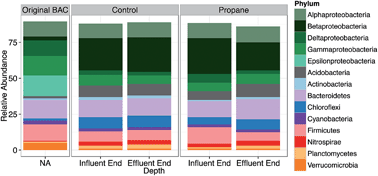Propane biostimulation in biologically activated carbon (BAC) selects for bacterial clades adept at degrading persistent water pollutants†
Abstract
Biologically activated carbon (BAC) can be used in both municipal water and hazardous waste remediation applications to enhance contaminant attenuation in water; however, questions remain about how selective pressures can be applied to increase the capabilities of microbial communities to attenuate recalcitrant contaminants. Here we utilized flow-through laboratory columns seeded with municipally derived BAC and exposed to water from a local drinking water facility to query how propane biostimulation impacts resident microorganisms. Ecological analyses using high throughput phylogenetic sequencing revealed that while propane did not increase the total number of microbiological species, it did select for bacterial communities that were distinct from those without propane. Temporal extractions demonstrated that microbial succession was rapid and established in approximately 2 months. A higher density of propane monooxygenase genes and bacterial clades including the Pelosinus and Dechloromonas genera suggest an enhanced potential for the degradation of persistent water pollutants in propane-stimulated systems. However, the ecological selective pressure was exhausted in less than 15 cm of transit in this flow-through scenario (25 hour retention) indicating a pronounced zonation that could limit the size of a biostimulated zone and require physical mixing, hydraulic manipulation, or other strategies to increase the spatial impact of biostimulation in flow-through scenarios.


 Please wait while we load your content...
Please wait while we load your content...